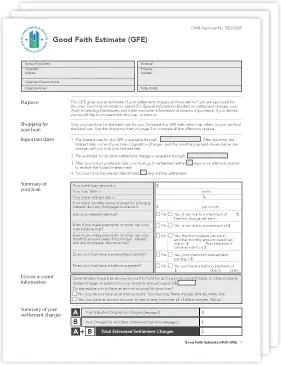
If you apply for a mortgage after October 3rd, 2015, you likely won’t see your closing costs listed on a GFE. Instead, you’ll get a new form called a Loan Estimate that will provide a detailed list of your estimated closing costs. Find out about the Loan Estimate here.
No one likes hidden fees. Beyond the actual monetary cost, there’s the added injury of being tricked into paying an amount you didn’t agree to. It’s frustrating, and if the fees are big enough, they can do some serious financial damage. That’s why, way back in 1974, congress passed a law known as RESPA, the Real Estate Settlement Procedures Act. Before then, it was too easy for mortgage lenders to squeeze extra money out of borrowers during the closing process. Homebuyers, eager to close on their house and not wanting to start over in the loan application process, were perfect targets for hidden fees.
Not anymore. After you send in a loan application, your lender has three days to get you a full rundown of the fees you’ll be charged for closing on that loan. This is called a good faith estimate, or GFE, and your lender is required by law to give you one. With one of these in hand the idea is that you shouldn’t get hit with any surprises. It helps you compare loan offers and better understand the true cost of the loan.
So what does a GFE look like?
A good faith estimate is a standardized form that has a long list of the terms of your loan, specifically the fees due at closing. While different GFEs from different lenders will have some minor aesthetic differences, the contents should all be the same because the good faith estimate rules apply to all lenders. Specifically, in the portion of the form that lists closing costs, there should be 11 separate “blocks” containing different costs, and the types of fees listed in these boxes should remain the same regardless of your lender. Check out our good faith estimate sample.

In total, there’s around 20 different types of costs and fees you may find on a GFE. These can be divided into three groups: fees that can increase any amount at closing, fees that can increase by up to 10% and fees that cannot increase at closing for any reason. We’ll take these three categories one by one. (If you want a full rundown of every single possible closing cost, including a definition and an estimate for each, check out SmartAsset’s closing cost calculator.)
Fees that can increase include the items in blocks 9, 10 and 11: initial escrow deposit, interest charges accrued between the settlement date and the period covered by the first mortgage payment and homeowners insurance. Each of these is determined based on the timing of your home purchase, and thus will fluctuate if you end up closing sooner or later than expected.
Fees that can increase up to 10% include the items in blocks 3, 4, 5, 6 and 7: title services and lender’s title insurance, government recording fees and any other services or charges for which your lender has chosen or suggested a provider, like an appraisal or home inspection. These costs are only capped if you use the provider suggested by your lender. If you choose your own provider, all bets are off.
Fees that can’t increase are the items listed in blocks 1 and 2, as well as the transfer taxes listed in block 8. Blocks 1 and 2 contain those costs directly associated with your mortgage lender, namely your origination charge and, if you get an interest rate lock, your interest credit or charge (also called points). Your origination charge should never increase for any reason. The amount you are charged for points depends on the interest rate your lender is offering you, so it’s important to get an interest rate lock to keep that fee fixed. Without a lock, your lender can charge you more for points at closing.
What is an interest rate lock?

Basically, an interest rate lock is an agreement between you and your lender that sets the interest rate offered to you. A rate lock can be good for fifteen to ninety days but the most common length is 30 days. During that period, if you close on a home, your lender is required to provide you a loan at the agreed-upon rate. Even if interest rates in the economy at large go up, your rate is fixed. That happens more than you might think, as rate spikes can be hard to predict.
Let's say you apply for a loan at a time when rates have been falling for months. You might expect to get an even lower rate if you don't get a rate lock. Instead, rates jump half a percent in the two months after your loan application. That could add up to tens of thousands of dollars in extra interest payments over the course of your loan.
Of course, interest rate locks aren’t always free, especially if you get your rate locked in for a longer period. You may have to pay extra points as a part of that deal. In either case, if you do get a rate lock, make sure it’s in writing, and make sure you have a good faith estimate that clearly states the rate and points you’ve agreed on. If necessary, you can ask for a new GFE.
Can I get more than one GFE?
If you agree on an interest rate lock, or your loan application otherwise changes, your lender should be willing to provide you with a new GFE. You can also get a good faith estimate from more than one lender. In fact, many homeowners get GFEs from three or four lenders so that they can compare the different offers each lender makes. Having multiple GFEs in hand allows you to shop around for a mortgage and make sure you are getting the most favorable terms available. You can even use a GFE from one bank to get a better offer from another. Remember: lenders want your business. If they see that you’re considering other options, they may fight harder to get you a loan.
Does applying for multiple loans hurt my credit?
For most types of loans, like credit cards or retail accounts, the credit rating agencies ding borrowers who apply for multiple accounts in a short period, but they make an exception for mortgages. As long as all of your applications are processed within a single 30-day period, you shouldn’t be penalized for the extra applications. That gives you the freedom to compare lenders, separate the bad deals from the good, and, in the end, pick the best offer out there. Which, after all, is the reason we have good faith estimates in the first place.
